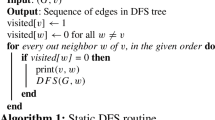Abstract
Based on Tucker's work, we present an accurate proof of the characterization of proper circular arc graphs and obtain the first efficient parallel algorithm which not only recognizes proper circular arc graphs but also constructs proper circular arc representations. The algorithm runs inO(log2 n) time withO(n 3) processors on a Common CRCW PRAM. The sequential algorithm can be implemented to run inO(n 2) time and is optimal if the input graph is given as an adjacency matrix, so to speak.
Similar content being viewed by others
References
D. Z. Chen and D. T. Lee. Solving the all-pair shortest path problem on interval and circular-arc graphs.Proceedings, International Parallel Processing Symposium, pp. 224–228, 1994.
L. Chen. NC algorithms for circular-arc graphs. In F. Dehne, J.-R. Sack, and N. Santoro, editors,Proceedings, Workshop on Algorithms and Data Structures, Lecture Notes in Computer Science, Vol. 382, pp. 291–302. Springer-Verlag, Berlin, 1989.
L. Chen. Optimal parallel time bounds for the maximum clique problem on intervals.Inform. Process. Lett., 42(4):197–201, June 1992.
L. Chen. Efficient parallel recognition of some circular arc graphs, I.Algorithmica, 9(3):217–238, March 1993.
L. Chen. Revisiting circular arc graphs. In D.-Z. Du and X.-S. Zhang, editors,Proceedings, 5th Annual International Symposium on Algorithms and Computation, Lecture Notes in Computer Science, Vol. 834, pp. 559–566. Springer-Verlag, Berlin, 1994.
L. Chen and Y. Yesha. Parallel recognition of the consecutive ones property with applications.J. Algorithms, 12(3):375–392, September 1991.
L. Chen and Y. Yesha. Efficient parallel algorithms for bipartite permutation graphs.Networks, 23(1): 29–39, January 1993.
D. R. Fulkerson and O. A. Gross. Incidence matrices and interval graphs.Pacific. J. Math., 15: 835–855, 1965.
M. R. Garey, D. S. Johnson, G. L. Miller, and C. H. Papadimitriou. The complexity of coloring circular arcs and chords.SIAM J. Algebraic Discrete Methods, 1:216–227, 1980.
X. He and Y. Yesha. Parallel recognition and decomposition of two terminal series parallel graphs.Inform. and Comput., 75:15–38, 1987.
W.-L. Hsu. A simple test for the consecutive ones property. In T. Ibaraki, Y. Inagaki, K. Iwama, T. Nishizeki, and M. Yamashita, editors,Proceedings, Annual International Symposium on Algorithms and Computation, Lecture Notes in Computer Science, Vol. 650, pp. 459–468. Springer-Verlag, Berlin, 1992.
R. M. Karp and V. Ramachandran. Parallel algorithms for shared-memory machines. In J. van Leeuwen, editor,Handbook of Theoretical Computer Science, Vol. A, pp. 869–941. North Holland, Amsterdam, 1990.
C. C. Lee and D. T. Lee. On a circle-cover minimization problem.Inform. Process. Lett., 18(2): 109–115, 1984.
D. T. Lee, M. Sarrafzadeh, and Y. F. Wu. Minimum cuts for circular-arc graphs.SIAM J. Comput., 19(6):1041–1050, December 1990.
M. V. Marathe, H. B. Hunt, III, and S. S. Ravi. Efficient approximation algorithms for domatic partition and on-line coloring of circular arc graphs. In O. Abou-Rabia, C. K. Chang, and W. W. Koczkodaj, editors,Proceedings, 5th International Conference on Computing and Information, pp. 26–30, 1993.
S. Masuda and K. Nakajima. An optimal algorithm for finding a maximum independent set of a circular-arc graph.SIAM J. Comput., 17(1):41–52, 1988.
J. B. Orlin, M. A. Bonuccelli, and D. P. Bovet. AnO(n 2), algorithm for coloring proper circular arc graphs.SIAM J. Algebraic Discrete Methods, 2:88–93, 1981.
W.-K. Shih, T. C. Chern, and W.-L. Hsu. AnO(n 2 logn) algorithm for the Hamiltonian cycle problem on circular-arc graphs.SIAM J. Comput., 21(6):1026–1046, December 1992.
J. Spinrad, A. Brandstädt, and L. Stewart. Bipartite permutation graphs.Discrete Appl. Math., 18:279–292, 1987.
A. C. Tucker. Matrix characterization of circular-arc graphs.Pacific J. Math., 39(2):535–545, 1971.
Author information
Authors and Affiliations
Additional information
Communicated by D. T. Lee.
Portions of this paper appear in preliminary form in theProceedings of the 1989Workshop on Algorithms and Data Structures [2], and theProceedings of the 1994International Symposium on Algorithms and Computation [5].
Rights and permissions
About this article
Cite this article
Chen, L. Efficient parallel recognition of some circular arc graphs, II. Algorithmica 17, 266–280 (1997). https://doi.org/10.1007/BF02523192
Received:
Revised:
Issue Date:
DOI: https://doi.org/10.1007/BF02523192




